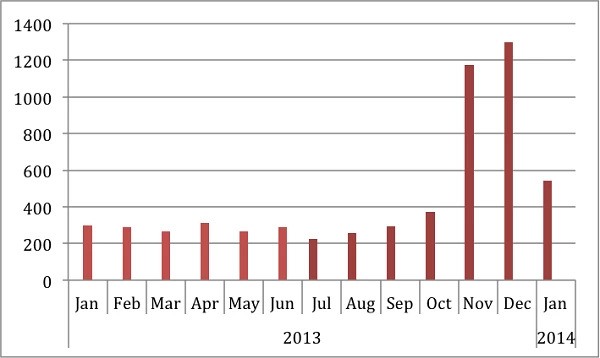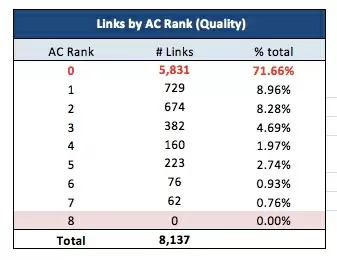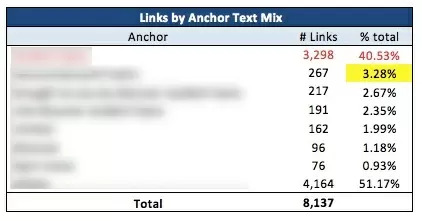With Google’s next Penguin update potentially right around the corner, there’s no better time to perform a link audit on your site.
Link audits look at the volume and quality of links in your link profile to ensure it’s balanced, healthy (meaning your website is getting good value from the links) and won’t trigger any unwanted penalties by Google. It’s also important to be proactive with your link audit, meaning don’t wait until the next Penguin update hits.
If you haven’t done it in a while – or ever – it should be the first thing you do before investing in other activities like content creation (aka additional link building). After that, you should prepare to do a link audit every three months to stay on top of your link profile.
Approach a link audit in two ways: quantitative and qualitative, which looks at the number of backlinks to your site and the quality of those links.
While quantitative research usually highlights any unnatural recent growth in the total number of backlinks, qualitative often assess the entire health of the link portfolio.
A 4-step process for assessing link quality
Let’s look at four steps you can take to assess the quality of your backlink profile in a link audit. To pull data, you’ll use tools like Majestic and Google Webmaster Tools (GWT). (Remember, GWT and Majestic integrate with BrightEdge’s S3 platform, too.)
1. Look at link growth by month (quantitative)
Look at the link data by month. You can do this by exporting the data from the tools into an Excel spreadsheet. The following graph shows an example site; the sharp increase in link growth over two month’s time is alarming:  The next step of this type of analysis is asking, “Why?” Oftentimes, you won’t find an immediate answer to the unnatural link growth you’re seeing.
The next step of this type of analysis is asking, “Why?” Oftentimes, you won’t find an immediate answer to the unnatural link growth you’re seeing.
If you work in an enterprise-level company, the answer may be even harder to uncover when multiple teams have a hand in the website. Oftentimes, it can be the result of some marketing activity that wasn’t pre-approved or assessed by the company’s SEO team. Perhaps someone paid for links or had sponsored content go live on a large number of publishers.
Whatever the cause, it’s your job as a link auditor to uncover it, and assess if it truly is something of concern.
2. Look at the link's AC rank (qualitative)
“AC Rank” aka “a citation rank” is an important performance indicator in Majestic’s reporting that checks the quality of backlinks. Therefore, AC Rank is a simple measure of how important a particular Web page is. AC Rank assigns a number from 0 (lowest) to 15 (highest), depending on the number of unique referring external root domains.
In other words, it assesses how many backlinks the website has that’s linking to your site. In order for a page to have an AC Rank of 1 or higher, it needs to have at least one external backlink. You can download a report that shows AC Rank in Majestic. In the following example, you can see the majority of the site’s backlinks come from other sites with an AC Rank of 0. 
While there isn’t a strict guideline on what percentage of a site’s backlink profile should contain links with an AC Rank of any number, you may want to look at your competitors to gauge a benchmark. And then consider building links with a higher AC Rank. There’s a manual review process involved here as well.
Once you identify the low AC Rank sites, you’ll want to visit at least some of the links and do a quality check to see if the site looks OK, or if it is of concern. Are there too many ads? Too many links pointing out? Create a checklist of how you might assess the quality of the site.
3. Conduct anchor text analysis (qualitative)
Anchor text is the word or words used in the link (the clickable text in a hyperlink). Anchor text helps search engines understand what the page is about that they are going to visit. The search engines used to view anchor text as a strong signal in ranking websites. Because of this, spammers attempted to manipulate search engine rankings by creating a large volume of unnatural links that contained a specific keyword pointing to a site. When the Google Penguin update first hit in April 2012, it essentially put the kibosh on those spammer activities. With Penguin, Google reduced the amount of weight that the anchor text has, and even penalized some sites that had too many anchor text links with the same keyword pointing to them. Let’s quickly go over the different types of anchor text.
- Exact match anchor text: The keywords in the link are the exact keyword you are trying to generate more visibility for in the search engines.
- Partial match anchor text: The links include the keyword you are trying to generate more visibility for, in addition to other words.
- Zero match (or generic) anchor text: Links that don’t include any mention of the keyword you are trying to generate more visibility for. Example: “click here.”
- Branded anchor text: Links with the brand name or URL of a website in them.
- All variations of naked URLs: Such as www.example.com, example.com and http://www.example.com.
There isn’t any rule on the percentage mix for having different types of anchor text pointing to your site. But stay away from emphasizing only one or two types of anchor text. A healthy anchor text profile should be a mixture of all of the above. As a general rule of thumb, branded (including branded naked URLs) should make up four out of your top five anchor texts. In the following image, you can see there were too many exact match anchor text for this sample site (keywords blurred out to protect the brand): 
4. Perform a backlinks analysis by IP address
Too many backlinks from the same IP address will not give any value to the site. And, too many backlinks from different domains but the same IP address (when brands own multiple websites, for example) could hint at a possible link scheme network of sites, which is classified as a bad SEO practice by Google.
For more on what Google thinks is a link scheme, see its documentation here. In this step, you’ll want to document all the links coming from a single IP address, and assess whether or not the mix of links is quality. You can do so with Majestic’s reporting. The result of all the steps in this four-step process will show you which domains are “bad” domains to have links from, and then you’ll decide how to handle them next.
How to handle bad links?
You now have a good picture of the volume and quality of your backlink profile – now what? Sometimes this next step in the process can be long and methodical, since you have no control over who links to your site. But, there are a few ways you can go about cleaning up those links you want to get rid of.
- Contact the webmaster of the site that’s linking to you. Put together a template that you will use for every site’s webmaster, and ask that the link either be taken down or nofollowed, depending on the severity. You’ll want to try this several times.
- Hire an agency to clean up your links. There are agencies that specialize in link audits and pruning your site’s backlinks for you. This saves you time and resources.
- Use Google’s disavow tool. Google gives webmasters a tool to use as a last resort to disavow links pointing to their sites. Google was very specific about how and when to use this tool, and you can read the guidelines here.
Here’s a video by Google’s Matt Cutts explaining how the disavow tool works: I hope this link audit process helps you keep your site healthy and your links working to your advantage. Remember, a link audit can be a time-intensive process, but it’s worth the effort being proactive rather than waiting to deal with a penalty that will catapult you into the same process anyway.


